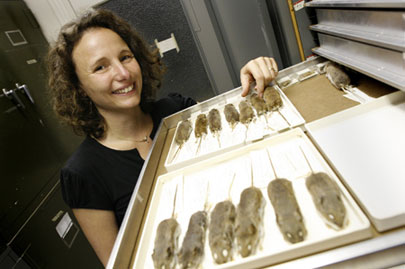Virginie Millien: Nature's archivist
Virginie Millien: Nature's archivist McGill University
User Tools (skip):
Profile
Virginie Millien: Nature's archivist

Virginie Millien, seen here with rodent specimens from her fieldwork this past summer in Schefferville, started training as a geologist before turning to paleontology. "Geology is a very male field," she laughs. "I wasn't comfortable with all the bad jokes."
Owen Egan
As a child in the suburbs of Paris, Virginie Millien had a passion for two things—collecting and organization. "I had collection mania, so my bedroom was always full of rocks and bugs," she remembers. "But for several years I had to share my room with my little brother—what a disaster! He was so disorganized I spent most of my time cleaning up after him."
Today, as the Redpath Museum's first curator of paleontology and zoology, Millien has found the perfect outlet for her early preoccupations, overseeing the vast collection of almost 300,000 plants, animals and minerals. And no brother in sight.
Few people have Millien's intimate knowledge of the museum's extensive holdings. Since being named to her current position a year ago, Millien has spent most of her time combing the Redpath's subterranean storage area doing a complete inventory of natural history specimens—the first time in the museum's history such a task has ever been undertaken. In the past, professors would act as curators of the specimens that fell under their particular area of interest, but no one was responsible for the collection as a whole.
More than just an exercise in bookkeeping, Millien's year-long labour has shed new light onto parts of the collection that have lived in the shadows for years. "We discovered him last week—a Carolina parakeet," she says, pointing to a small colourful bird mounted under glass in her office. "When he first came to the museum, he was probably just another mount of a bird native to North America. But now this type of bird is extinct, which makes him very important. It gives us a real sense of why museums matter. They are nature's archives." Having spent years anonymously tucked away amid a flock of other, less rare, parrots, this Carolina parakeet will soon take a perch of prominence on the museum floor.
Millien uses the word "archive" where others might say "repository" because for her the museum is not just a holding tank for fossils and glass-eyed grizzly bears. The Redpath is a huge scientific tool. "This is not just a collection of curiosities, as it once was," she says. "Now we're here to provide specimens for research—and that is my priority. For example, I get requests all the time for whiskers from my mice [for DNA research]."
Ah, Millien's mice. This past summer, her fieldwork saw her collecting rodent specimens in northern and southern Quebec to compare the variances in population and morphology between the geographic groups. Despite a rude introduction to Schefferville's voracious black flies ("they absolutely terrorized me"), Millien was invigorated by her fieldwork—so much so that she keeps dozens of rodent "study skins" (specimens mounted for scientific purposes) in a large filing cabinet on top of her desk. "Want to see them?" she asks, jumping up to pull out a tray resplendent with the tiny corpses of several dozen specimens.
When asked how a little girl from one of the world's great cosmopolitan centres developed her love of natural sciences, Millien smiles. "Maybe Jacques Cousteau—I never missed a program. But it didn't come from my parents, that's for sure. They can't tell a bird from a mouse."
Increasingly, Millien is enamoured with igniting in others that same spark of discovery that she felt as a child. While she acknowledges that she is a "behind-the-scenes person" at the Redpath, Millien revels in the museum's public face. "Every day, we hear kids saying 'Ah, dinosaurs!' It's great because we're helping another generation of kids learn to love science."
Millien has been especially inspired by working with McGill students as they assist her in the field and in the museum taking inventory. In addition to her ongoing love affair with all things collectable, Millien's experience with students this past year has inspired her to begin working toward becoming a professor, something of a departure for a person who so loves the solitary nature of her work. "I was always on the path toward doing my own research," she says. "But our students are really amazing because their enthusiasm makes me aware of why I am here and why I do this. In many ways, they remind me of myself when I was younger."

